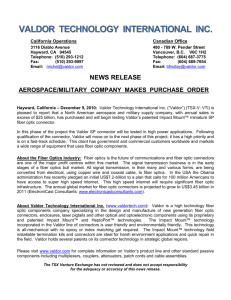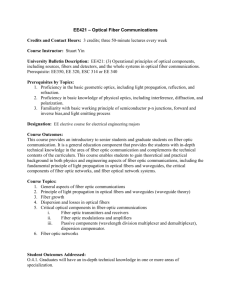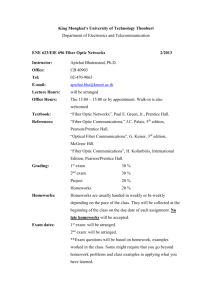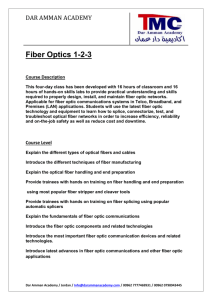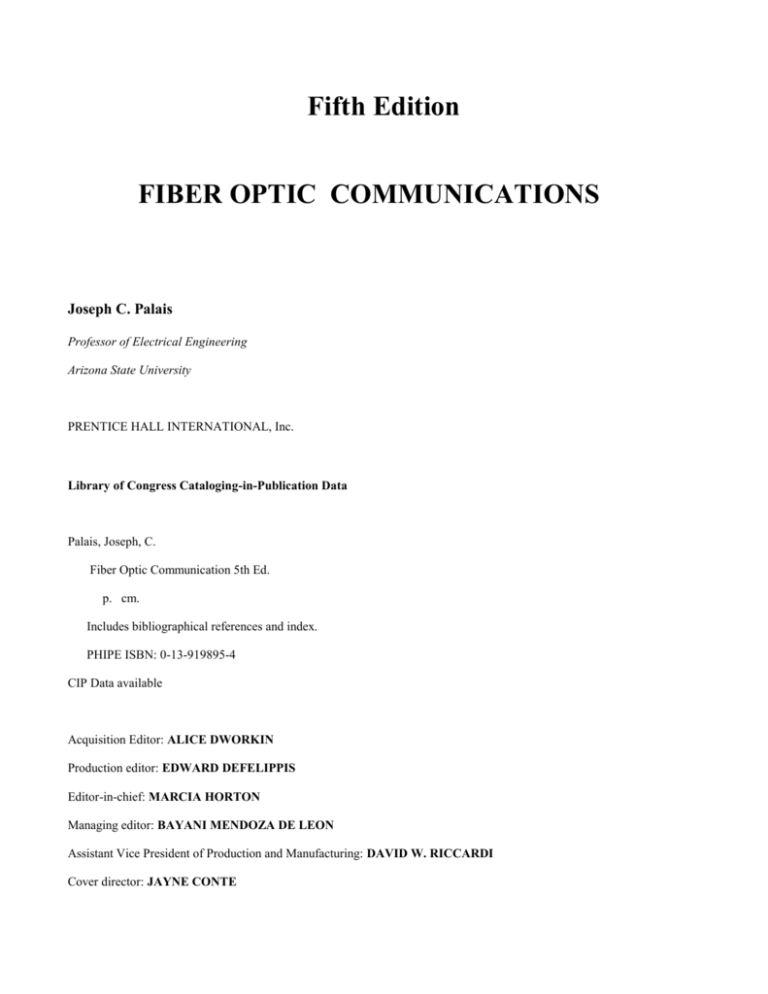
Fifth Edition
FIBER OPTIC COMMUNICATIONS
Joseph C. Palais
Professor of Electrical Engineering
Arizona State University
PRENTICE HALL INTERNATIONAL, Inc.
Library of Congress Cataloging-in-Publication Data
Palais, Joseph, C.
Fiber Optic Communication 5th Ed.
p. cm.
Includes bibliographical references and index.
PHIPE ISBN: 0-13-919895-4
CIP Data available
Acquisition Editor: ALICE DWORKIN
Production editor: EDWARD DEFELIPPIS
Editor-in-chief: MARCIA HORTON
Managing editor: BAYANI MENDOZA DE LEON
Assistant Vice President of Production and Manufacturing: DAVID W. RICCARDI
Cover director: JAYNE CONTE
Cover designer: BRUCE KENSELAAR
Copy editor: BOB LENTZ
Manufacturing buyer: JULIA MEEHAN
Editorial Assistant: NANCY GARCIA
Dedicated to my wife Sandra, my children Michael and Barbara, and my grandchildren Joshua and
Logan
©2004, 1998, 1992, 1988, 1984, by Prentice-Hall, Inc.
Simon & Schuster / A Viacom Company
Upper Saddle River, New Jersey 07458
All rights reserved. No part of this book may be
reproduced, in any form or by any means,
without permission in writing from the publisher.
The author and publisher of this book have used their best efforts in preparing this book. These efforts include the
development, research, and testing of the theories and programs to determine their effectiveness. The author and
publisher make no warranty of any kind, expressed or implied, with regard to these programs or the documentation
contained in this book. The author and publisher shall not be liable in any event for incidental or consequential
damages in connection with, or arising out of, the furnishing, performance, or use of these programs.
Printed in the United States of America
10 9 8 7 6 5 4 3 2 1
ISBN: 0-13-895442-9
Prentice-Hall International (UK) Limited, London
Prentice-Hall of Australia Pty. Limited, Sydney
Prentice-Hall Canada Inc., Toronto
Prentice-Hall Hispanoamericana, S.A., Mexico
Prentice-Hall of India Private Limited, New Delhi
Prentice-Hall of Japan, Inc., Tokyo
Simon & Schuster Asia Pte. Ltd., Singapore
Editora Prentice-Hall do Brasil, Ltda., Rio de Janeiro
Contents
PREFACE
xi
1
FIBER OPTIC COMMUNICATIONS SYSTEMS
1-1
Historical Perspective, 1
1-2
The Basic Communications Systems,
1-3
Nature of Light,
1-4
Advantages of Fibers,
1-5
Applications of Fiber Optic Communications,
1-6 Summary and Discussion,
Problems,
1
References,
2
OPTICS REVIEW
2-1
Ray Theory and Applications, XX
2-2
Lenses, XX
2-3
Imaging, XX
2-4
Numerical Aperture, XX
2-5
Diffraction, XX
2-6
Summary and Discussion, XX
XX
Problems, XX
References, XX
3
LIGHTWAVE FUNDAMENTALS
XX
3-1
Electromagnetic Waves, XX
3-2
Dispersion, Pulse Distortion, and Information Rate, XX
3-3
Polarization, XX
3-4
Resonant Cavities, XX
3-5
Reflection at a Plane Boundary, XX
3-6
Critical-Angle Reflections, XX
3-7
Summary, XX
Problems, XX
References, XX
4
INTEGRATED OPTIC WAVEGUIDES
XX
4-1
Dielectric Slab Waveguide, XX
4-2
Modes in the Symmetric Slab Waveguide, XX
4-3
Modes in the Asymmetric Slab Waveguide, XX
4-4
Coupling to the Waveguide, XX
4-5
Dispersion and Distortion in the Slab Waveguide, XX
4-6
Integrated Optic Components, XX
4-7
Summary and Discussion, XX
Problems, XX
References, XX
5
OPTIC FIBER WAVEGUIDES
XX
5-1
Step-Index Fiber, XX
5-2
Graded-Index Fiber, XX
5-3
Attenuation, XX
5-4
Modes and Fields in Step-Index Fibers, XX
5-5
Modes and Fields in Graded-Index Fibers, XX
5-6
Pulse Distortion and Information Rate in Optic Fibers, XX
5-7
Construction of Optic Fibers, XX
5-8
Optic Fiber Cables, XX
5-9
Summary and Discussion, XX
Problems, XX
References, XX
6
OPTICAL SOURCES AND AMPLIFIERS
XX
6-1
Light-Emitting Diodes, XX
6-2
Light-Emitting-Diode Operating Characteristics, XX
6-3
Laser Principles, XX
6-4
Laser Diodes, XX
6-5
Laser-Diode Operating Characteristics, XX
6-6
Narrow Spectral Width and Tunable Laser Diodes, XX
6-7
Optical Amplifiers, XX
6-8
Fiber Lasers, XX
6-9
Vertical-Cavity Surface-Emitting Laser Diodes, XX
6-10 Summary and Discussion, XX
Problems, XX
References, XX
7
LIGHT DETECTORS
7-1
Principles of Photodetection, XX
7-2
Photomultiplier, XX
7-3
Semiconductor Photodiode, XX
7-4
PIN Photodiode, XX
7-5
Avalanche Photodiode, XX
7-6
Summary and Discussion, XX
XX
Problems, XX
References, XX
8
COUPLERS AND CONNECTORS
8-1
Connector Principles, XX
8-2
Fiber End Preparation, XX
8-3
Splices, XX
8-4
Connectors, XX
XX
8-5
Source Coupling, XX
8-6
Summary and Discussion, XX
Problems, XX
References, XX
9
DISTRIBUTION NETWORKS AND FIBER COMPONENTS
9-1
Distribution Networks, XX
9-2
Directional Couplers, XX
9-3
Star Couplers, XX
9-4
Switches, XX
9-5
Fiber Optical Isolator, XX
9-6
Wavelength-Division Multiplexing, XX
9-7
Fiber Bragg Gratings, XX
9-8
Arrayed-Waveguide Gratings, XX
9-9
MEMS Switches, XX
XX
9-10 Other Components: Attenuator, Circulator, and Polarization Controller, XX
9-11 Summary and Discussion, XX
Problems, XX
References, XX
10
MODULATION
XX
10-1 Light-Emitting-Diode Modulation and Circuits, XX
10-2 Laser-Diode Modulation and Circuits, XX
10-3 Analog-Modulation Formats, XX
10-4 Digital-Modulation Formats, XX
10-5 Electroabsorption Modulator
10-6 Optic Heterodyne Receivers, XX
10-7 Summary and Discussion, XX
Problems, XX
References, XX
11
NOISE AND DETECTION
XX
11-1 Thermal and Shot Noise, XX
11-2 Signal-to-Noise Ratio, XX
11-3 Error Rates, XX
11-4 Modal Noise, Mode-Partition Noise, Amplifier Noise, Laser Noise, and Jitter, XX
11-5 Additional Noise Contributors, XX
11-6 Receiver Circuit Design, XX
11-7 Summary and Discussion, XX
Problems, XX
References, XX
12
SYSTEM DESIGN
XX
12-1 Analog System Design, XX
12-2 Digital System Design, XX
12-3 Summary and Discussion, XX
Problems, 322
References, 323
BIBLIOGRAPHY
XX
ANSWERS
XX
INDEX
XX
Preface
Fiber optic communications developed very quickly after the first low-loss fibers were produced in 1970. Operational fiber
systems are now common, and new installations and applications appear continually. Communication by fibers has taken over
many of the functions previously performed by copper-based systems and extended them significantly. Fibers have become
an enabling technology in the information society in which we live. They work together with the remaining copper
applications and the growing wireless infrastructure to meet our expanding communications needs.
Fiber technology has matured sufficiently so that many books have been written on the subject. Some of these books are
quite detailed in terms of theoretical and mathematical content, and the beginner may find the level difficult.
This text is intended to be less difficult, while still bringing to the reader the information necessary to understand the
design, operation, and capabilities of fiber systems. Important theoretical and mathematical results are given without the
accompanying lengthy proofs. However, results are explained in physical terms when possible and appropriate, and extensive
tables and figures are used to make those results readily usable. To provide a realistic view, numerical values are given for the
range of typical device parameters.
When the first edition of this book appeared in 1984, fibers had already crisscrossed much of the United States and
many other countries to deliver telephone messages between the major exchanges. By 1988, when the second edition was
published, the land-based long-distance fiber telephone network was nearly complete, and submarine fiber telephone cables
were being installed beneath the major oceans. In addition, fiber optic local-area networks (LANs) were in development.
When the third edition went to press in 1992, over 10 million kilometers of fiber had been installed worldwide, undersea
cables were being constructed, and installation of fiber LANs was increasing. By 1998, when the fourth edition was
published, numerous submarine fiber cables covering the Atlantic and Pacific oceans and many other smaller seas were
operational. In addition, numerous tests had been completed for bringing fiber to all homes, holding the promise for
expanded services to the individual subscriber. With this fifth edition, we note several new developments. The demand for
more transmission bandwidth (particularly for Internet and business applications) has required design of fiber systems
carrying information at terabit per second rates over great distances. Metropolitan area networks (MANs) have become
significant parts of the fiber industry. Bringing fiber connections to the home is still a goal, but an allusive one. Economic
considerations have slowed progress in this direction.
It is the insatiable demand for greater bandwidth that makes this fifth edition necessary The fundamentals have not
changed, but new technological advances and improvements have emerged to satisfy this demand. I have attempted to work
these new ideas into the previous edition with as little disruption as possible.
This is an introductory book. No background in fiber optics, or optic communications, is presumed. Only the simplest
concepts from algebra and trigonometry are invoked in explaining the characteristics of fiber systems. Appropriate
background material on optics, electronics, and communications is introduced in the text as needed.
This book was originally based on a set of notes I developed and used for numerous short courses on fiber optic
communications. Participants in these courses had training ranging from two years of technical school through the Ph.D. level.
Jobs varied from designer to board chairman. Attendees included personnel from industry, government, and academia.
Individual backgrounds were in chemistry, physics, and many areas of engineering. In addition to the short course
presentations, I have taught this material to over fifteen hundred electrical engineering students at the senior and first-year
graduate level. The course has been taught over television for more than twenty years. In the last few years it has also been
available as an Internet-delivered class.
The professionals benefiting from this book include practicing design engineers concerned with the selection and
application of components and with the design and evaluation of systems. Knowledge of the entire system is useful for the
device designer as well. Others involved in fiber optics, such as high-level engineering decision makers, project managers,
technicians, marketing and sales personnel, and teachers, can also obtain valuable information from the material presented.
The organization of the book is as follows. Block diagrams of entire fiber optic systems are presented at the outset. This
identifies the components of fiber systems, providing motivation for their individual study in succeeding chapters. Chapters 2
and 3 contain a review of important results from the fields of optics and wave travel. This basic information is needed for an
understanding of fiber optic devices and systems. Chapter 4, on integrated optics, introduces the technology of combining
optic components onto a single substrate. The integrated-optic waveguide provides an excellent, simplified model for
propagation of light in a fiber. Chapters 5 – 9 present the main devices encountered in a fiber optic system. These are the fiber,
light source, light detector, couplers, and distribution networks. System considerations appear in Chapters 10 – 12, where
modulation formats, the effects of noise on message quality, and system design are covered. The last chapter includes
examples of operational systems. In this chapter, the design information developed throughout the book is applied to realistic
problems.
I expect the reader who has mastered this material to be able to design and specify systems and to choose and evaluate
system components such as fibers, light sources, detectors, and couplers. Commercially available subsystems, such as
complete transmitters and receivers, will also be amenable to evaluation by the techniques presented in this book.
This new and fully revised edition of Fiber Optic Communications incorporates significant advances made in the fiber
industry since publication of the fourth edition. Because the fundamentals of the technology have remained the same, the
number of changes is moderate. Nonetheless, the changes and additions are significant. Added or expanded topics include:
Raman amplifier, erbium-doped waveguide amplifier, the arrayed waveguide grating, electroabsorption modulator, optical
micro-electro-mechanical (MEMs) components, dispersion compensation, tunable light sources, tunable filters, optical timedivision multiplexing, dense and course wavelength-division multiplexing, increased utilization of the optical spectrum, and
emphasis on external modulation. A new table showing the most current spectral band classification scheme has been added.
Small form factor connectors and non-adhesive splices are described. In addition, the discussions in a number of sections
were modified to improve clarity of the presentation.
Because numerous colleges adopted the initial text for an undergraduate course in fiber optics, a homework problem set
was inserted in the second edition. New problems have been added and several of the old ones have been updated for this new
edition, making this text’s use in the classroom even more desirable. Some problems are merely “plug-in”-type questions
intended to give the student practice and confidence in understanding of the material presented. Other problems take more
thought and may even require finding and reviewing material from other sources. Answers to most problems appear at the end
of the book, and a new solutions manual is available for instructors.
Many new references have been added. The bibliography and periodicals listing at the end of the text provides a
resource for further study. The bibliography includes older “classic” fiber optics presentations and several newer ones that
have appeared since the last edition of this textbook.
I find that the first seven chapters can be covered in a one-semester course. This introduces all the major system
components to the students, allowing those who have mastered the material to productively enter into the fiber industry. The
last five chapters, on more advanced topics, can be covered in a second term. To simplify the mathematics and reach a wider
audience, many of the results presented in the text are not fully derived. Instructors of well-prepared students, such as seniors
in electrical engineering programs, may wish to fill in the derivations to deepen student understanding.
FIBER OPTIC SOFTWARE
All technical workers and students have access to personal computers and the internet. Because of this, many groups have
developed software to illustrate fiber-related phenomena and to aid analysis and design. Several such programs are available
through my home page (www.eas.asu.edu/~palais). Some of these are available on CDs for instructors adopting the textbook.
In addition, PowerPoint slides covering much of the textbook material are available on CDs to assist lecturers.
ONLINE COURSE AVAILABILITY
A two-semester course covering the material in the textbook is available online (and on CDs or DVDs) for university credit,
for continuing education credit, or for self study. The online version contains lectures by the author, demonstrations,
homework, and exams. Contact the author for information (joseph.palais@asu.edu).





